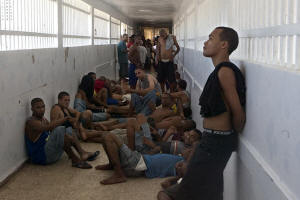Dominican officials cram thousands of inmates facing no charges into
overcrowded prisons
 Send a link to a friend
Send a link to a friend
 [February 19, 2025]
By DÁNICA COTO [February 19, 2025]
By DÁNICA COTO
SANTO DOMINGO, Dominican Republic (AP) — They’re known as “frog men,”
inmates who are forced to sleep on prison floors across the Dominican
Republic, often next to overflowing toilets or holes in the ground that
serve as one.
Thousands of them are crammed into the country’s severely overcrowded
prisons, some operating at seven times their capacity. A majority
languish there without ever having been charged with a crime, and
activists warn they face inhuman conditions and a lack of medical care.
Despite promises to improve the system, critics say the Dominican
Republic continues to push for and allow pretrial detentions in nearly
all criminal cases where no charges have been filed and has made few
changes as problems within prisons keep mounting.
“Prisons have become no man’s land,” said Rodolfo Valentín Santos,
director of the Dominican Republic’s National Public Defense Office.
Over 60% of the country’s roughly 26,000 inmates are being held under
preventive detention, without any charges, according to the National
Public Defense Office. Proponents argue the measure aims to protect
society and allows authorities time to collect evidence in a case.
But some detainees have spent up to 20 years in prison without ever
being found guilty of a crime, Valentín said.
He noted that the country’s Constitution and penal code dictate that
preventive detention is an “exceptional” measure. There are six other
measures that don’t involve prison time, including bail, but Valentín
said they are rarely used.

‘We have a situation’
On a recent afternoon, Darwin Lugo and Yason Guzmán walked out of La
Victoria National Penitentiary, in the northeast corner of the sprawling
capital, Santo Domingo.
The prison was built for a maximum of 2,100 inmates but holds more than
7,000 of them, with more than 3,300 under pretrial detention, according
to the National Public Defense Office.
It is the country’s oldest and most populated prison.
“You have to watch out for your life,” said Lugo, who with Guzmán
visited several friends held there, some under pretrial detention.
“There are a lot of them who are not doing well,” Guzmán said of inmates
there. “There’s extreme poverty.”
They said their friends, who have spent more than five years
incarcerated there, are well-connected and only occasionally request
money or ask that their cell phone’s SIM card be recharged.
Last year, at least 11 inmates died at La Victoria following a short
circuit in a cell that sparked a fire and an explosion. It was one of
the country’s deadliest prison fires since 2005, when at least 134
inmates were killed in the eastern town of Higüey after rival gangs set
their bedding ablaze.
After last year’s fire at La Victoria, Dominican President Luis Abinader
appointed former prisons director Roberto Santana as head of a
commission tasked with overhauling and improving the country’s more than
40 prisons.
“We must admit, gentlemen, that we have a situation in all of the
country’s prisons,” Abinader said when he announced the appointment last
March. He also announced that money recovered from corruption cases
would help fund construction of new prisons.
Santana has long called for the closure of La Victoria and the 15 de
Azua prison, located in the country’s western region. The commission he
leads is working on those and other monumental tasks, free from outside
interference, he said.
“We don’t take orders from politicians or anyone else,” said Santana,
who previously trained staff for the new prisons built in the early
2000s.

[to top of second column]
|

Inmates stand inside a corridor during time they are allowed to be
outside of their cells at Najayo jail in San Cristobal, west of
Santo Domingo, May 30, 2007. (AP Photo/Ramon Espinosa, File)

Santana, who once served as president of the Federation of Dominican
Students in the 1970s, was arrested multiple times under President
Joaquín Balaguer, known for having political opponents and
dissidents jailed and sometimes killed.
Santana knows first-hand the conditions of La Victoria — he spent
two years in solitary confinement there.
‘On the brink of collapse’
In the early 2000s, the Dominican Republic began building 21 new
prisons to improve conditions. They were staffed by trained
personnel, not police and soldiers, which oversee the country's
other 19 prisons.
But conditions in the new prisons have deteriorated, according to
the Dominican Republic's National Commission of Human Rights.
“The Dominican Republic’s prison system is on the brink of
collapse,” the commission said in its 2023 report, the latest one
available.
In prisons across the country, overcrowding is rampant. Cells lack
bathrooms, natural light and ventilation, leading to worsening
health conditions. Some 5,000 inmates are ill with conditions
ranging from heart problems to cancer to HIV, but they receive only
the most basic medication, if that, and some prisons have no medical
staff, according to Valentín, whose office issues a yearly in-depth
report on the conditions of all prisons.
In its 2023 report, the latest year available, his office called for
the closure of prisons including one in the north coastal city of
Nagua.
“The level of overcrowding…makes it impossible to achieve true
rehabilitation for the inmates since they have been forgotten by the
state,” the report read. “In the conditions they are in, it is
obvious that they are treated as objects and not as human beings
endowed with rights.”
Another prison was so overcrowded that the government held inmates
outdoors in trucks with metal roofs that broiled under the sun,
sparking lawsuits, Valentín said.
A spokesperson for Col. Roberto Hernández Basilio, director of
prisons, did not respond to requests for an interview. Hernández has
previously said his office is taking measures to improve conditions.
Meanwhile, Dominican Attorney General Miriam Germán Brito has
repeatedly spoken out against pretrial detention but noted that the
decision lies in the hands of judges. A spokesperson for Germán said
she is not granting media interviews.

Both Santana and Valentín said they believe government corruption is
one reason the country has dragged its feet in overhauling the
system, accusing soldiers and police who run prisons of benefiting
from illegal activities.
Public corruption also prompted authorities to halt construction of
a much-touted prison in recent years that was expected to ease
overcrowding.
Even as that half-built prison wastes away, Santana said he expects
that 25 new prisons capable of holding more than 20,000 inmates will
be built by 2028.
While those are expected to help ease overcrowding, concerns remain.
Activists note that inmates are not freed even when a judge has
legally released them.
The National Commission of Human Rights noted that roughly 2,700
inmates are still in prison because their paperwork is paralyzed in
backlogged courts. Meanwhile, hundreds of others remain incarcerated
despite being officially freed because they owe the government money
and are unable to pay fines ordered by a judge.
All contents © copyright 2025 Associated Press. All rights reserved |